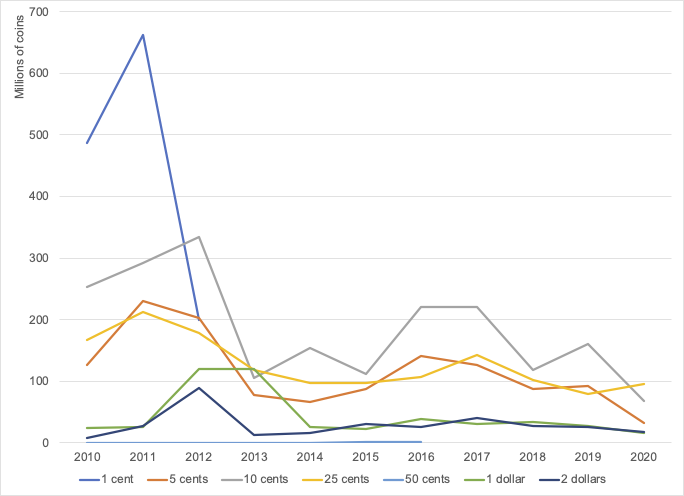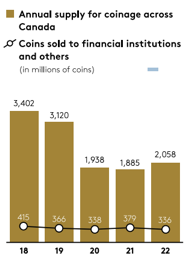Canada: Coins and Cash Acceptance
Royal Canadian MintAn industrial facility manufacturing coins. More: Coins Are Still Vital
“I think coins and digital payments will coexist for the foreseeable future, so we have to find a way that it’s done seamlessly.” – Marie Lemay, RCM’s president.
Between 2010 and 2020, the Royal Canadian Mint (RCM) produced 6,862,818,500 coins. By denominationEach individual value in a series of banknotes or coins. More, 10-cent coins and 25-cent coins were the most abundant, with 29.7% and 20.4% of the total (see Graph 1), followed by 1-cent coins (19.7%), 5-cent coins (18.5%), 1-dollar coins (7.03%) and 2-dollar coins (4.7%). In December 2022, the RMC issued a special 2-dollar coinA coin is a small, flat, round piece of metal alloy (or combination of metals) used primarily as legal tender. Issued by government, they are standardised in weight and composition and are produced at ‘mints’. More with a black outer ring to honor Queen Elizabeth II (1926-2002).
Graph 1. Royal Canadian Mint: Mintage by Denomination, 2010-2020

Source: Royal Canadian Mint (2023).
In February 2013, the RCM stopped producing pennies due to rising costs relative to face valueThe figure or amount written on the banknote or coin which indicates the amount of its economic value. It is usually written in letters and numbers. More. Since then, the demand for other coins has declined by nearly 8% each year. While the RCM’s supply for coinage dropped 37.8% in 2020 due to the Covid-19 pandemic, the supply increased 9% in 2022 (see Graph 2).
Graph 2. Royal Canadian Mint: Coinage Supply across Canada, 2018-2022

Source: Royal Canadian Mint (2022: 38).
Coin Recycling and Circulation
Canada did not experience disruptions in coins’ circulation as the United States did in 2020, during the Covid-19 pandemic. The RCM manages the national circulation coin management system, working with cash-in-transit companies and financial entities to assess coin demand and ensure coins go to their users, particularly in remote and rural regions with limited banking access and internet connectivity.
“Our goal is to make sure that we are always ensuring that people that want to use coins are able to do it, when and where they want to. […] We have a view into where coins are around the country, and we’re able to forecast. We’re able to move coins around […] and that allows us to have very efficient coin production.” – Marie Lemay, RCM’s president.
The RCM is committed to recyclingThe process of converting waste materials into new materials and objects. Banknotes are increasingly recycled after destruction, and the waste is often used for landfills, isolation material etc. Polymer notes are melted into pellets which are recycled into new products. Recycling is often incorrectly used instead of recirculation. See Recirculation. More coins: in 2022, the Mint met 77% of coin demand with recirculating coins, 7% with recycled coins, and the balance with new coin production (Royal Canadian Mint 2022: 15). The Mint encourages Canadians to take their changeThis is the action by which certain banknotes and/or coins are exchanged for the same amount in banknotes/coins of a different face value, or unit value. See Exchange. More to Coinstar recycling kiosks at grocery stores to get a cashMoney in physical form such as banknotes and coins. More voucher at checkout or customer service.
Small and Business Retailers Remain Committed to Accepting Cash
“When you give a pieceIn plural, it is commonly used as synonym for units of banknotes and coins. More of plastic to your grocer you’re giving a part of yourself. They feel that if a grocer goes cashless it would discriminate against people that actually do use cash, there are many underbanked or unbanked in Canada.” – Sylvain Charlebois, director of Agri-Food Analytics Lab at Dalhousie University.
In July 2023, a convenience store chain opened its first cashless, 24/7 store in Western Canada. “All you need is your phone to enter the store and pay for your go-to favourites,” said Vender Convenience. Customers unlock the store’s doors with their phones, add their purchased goods to the app or scan barcodes, and pay with debit or credit cards.
However, most Canadian retailers have yet to make plans to go cashless soon. In 2021-2022, the Bank of Canada conducted a Merchant Acceptance Survey to monitor paymentA transfer of funds which discharges an obligation on the part of a payer vis-à-vis a payee. More methods of small and medium businesses (SMBs) in retail trade, food services, and other services.
- The survey found that 97% of SMBs accepted cash. The share of merchants accepting only cash decreased from 31% in 2018 to 10% in 2021-2022 (Welte, Wu 2023: 6-7).
- Acceptance of cards increased from 67% in 2018 to 88% in 2021-2022. The share of merchants accepting cash, debit, and credit cards has risen from 61% (2018) to 84% (Welte, Wu 2023: 6).
- Most retailers (92%) expect to continue accepting cash. Only 3% of merchants said they are cashless and will remain so shortly (Welte, Wu 2023: 7, 17).
- Merchants stated they prefer accepting cash as it is the quickest and most reliable payment methodSee Payment instrument. More, albeit with the highest labor costs. They also considered debit cards nearly as reliable as cash. Retailers think credit cards have the highest fees and are the most risky payment method (see Graph 3).
Graph 3. Canada: Merchants’ Preferences Regarding Payment Methods, 2015-2022

Fuente: Welte, Wu (2023: 17).